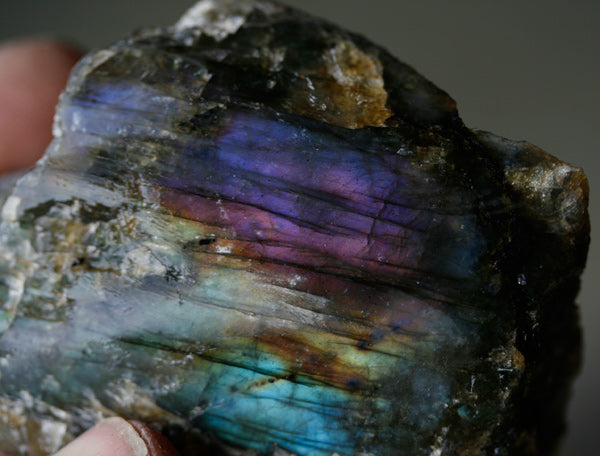All about Labradorite
Labradorite is a low key gray stone with a big surprise. When cut correctly for proper angle, high quality material displays a bright flash of color(s). Colors from the blue and yellow-orange portions of the visible light spectrum jump forth from the darker base stone. Only a small percentage of all of the labradorite mined is of high enough quality for our body jewelry - most is considered b-grade with little or no flash.
What is Labradorite?
Labradorite is a feldspar with a hardness of approximately 6 on the Mohs hardness scale, and it originates from Labrador, Canada as well as Madagascar and a few other locations around the world. It occurs most frequently as light to dark gray or gray-green in rough form with large crystalline planes and seams throughout. In high quality material the crystalline structure is such that at the right angle, it refracts a large spectrum of colors from various layers within the material.

Rough labradorite material at the ideal light angle for color flash. This color does not exist in the stone, it is a light-dependent color sheen. The same rough is shown below from a different angle, with minimal to no flash present.

Below, a close-up of labradorite's light play on rough stone.

Where does Labradorite come from?
Labradorite was first discovered in the late 1700's in Labrador, Canada. Since then, deposits have been noted in Finland, Russia, Australia, Mexico, United States and Madagascar. It is said that according to Eskimo Indian legend, the northern lights were freed from Labradorite.
The colors in Labradorite
The colors in Labradorite are not actually present in stone, rather they are the result of light play within the stone. Labradorite is a feldspar with a crystalline structure that forms very thin compacted layers. When light hits the surface of the stone, it travels down through the layers, which reflect, refract and diffuse the white light, absorbing some colors and reflecting others which we see as the flash on the surface of the stone.
We have had material with flash ranging in color from white (essentially clear with flash) through light yellow, orange and copper, fuchsia and purple, light aqua to dark aqua, light blue, dark blue and near blue-black. Specimens may contain one solid color, two colors, a color shift (both within the same spectrum such as aqua to dark blue, or even opposite spectrums such as from aqua to yellow), or multiple colors across the same cut face of stone. In our experience, the rarest colors are the fuchsia and purples as well as some transitional shades of pink-copper, and very light blue to true white flash. We do have some examples of these that we keep as display specimens in our showroom in Richmond, Virginia.
The labradoresence or schiller effect, as the flash is known, can be solid bright color, subdued “faded” flash color, flash only at certain angles, or create a “blinds” effect where lines of schiller flash on and off as the piece is moved. This “blinds” effect is uncommon, but particularly interesting because of the movement created within the piece as it ‘flutters.’ The flash effect always looks best in direct to diffused natural daylight, artificial light is not appropriate for viewing the true color and intensity of labradorite.

Very high quality material with vibrant true blue and copper. Flash of this quality from side to side within a stone is fairly rare.

Beautiful and unusual layered patterning with different colors.

Very uncommon pale peach and lavender coloration

True purple flash in labradorite is very rare.

Beautiful blue fade with 'shutter' effect. At different angles, what shows as blue now fades and the darker lines flash blue.

Lots of beautiful blues!
Working Labradorite into body jewelry
Making body jewelry from labradorite can be tricky due to the amount of time it takes to go from a large rough chunk of stone to a usable slab form cut in the correct manner for maximized flash across the face. Onetribe’s labradorite body jewelry consists of pieces cut for maximum flash on a case by case basis, and a great deal of time is put into selecting the best material for each project based on the needed size, color and shape. We aim for 85% or more solid flash across the faces of anything we create from this stone, and generally (not always but as frequently as possible) pieces will flash straight on when rotated to the correct viewing angle, allowing them to flash easily while being worn. Each piece of labradorite is 100% unique and we cannot guarantee color or pattern matches from project to project, especially when booking custom projects with past labradorite photos as references. We do not create concaves or tunnels from this material as it cuts through the flash, reducing or potentially eliminating any color that would otherwise be evident.



